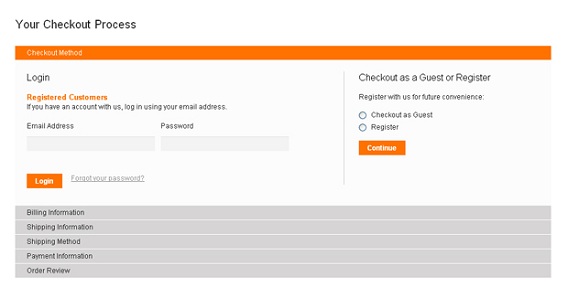Some of the most typical challenges any marketer faces include window shopping, saving goods for later, competitive prices (which will improve your site traffic rate), and searching for the most excellent deals and discount codes. You are unable to prevent clients from abandoning their shopping carts if you operate an online store. It’s an unavoidable component of running a company. However, one area in which you may make improvements is devising efficient means of recovering any lost carts with the help of a web development company in India.
According to recent statistics, a whopping 75.6 percent of customers who buy online abandon their carts before making a purchase. It’s also true that not every new visitor will become a repeat customer in the initial go-round. However, if those customers are interested in any of your items or services, either by adding them to the basket or just lingering over them, you may want to keep them on your site longer. In any case, there’s still a possibility to bring them back and sell them this time.
What is Cart Abandonment?
Shopping cart abandonment happens when a potential customer builds a wish list of products they want to purchase but never completes the transaction. It refers to a shopper leaving their items in the shopping bag but not making the purchase. Customers who have reached this point in the purchasing cycle have already expressed a willingness to buy the product and are actively engaged with a brand.
The “abandoned cart” campaign is the most successful way to send a prompted email to many online retail firms. In order to better understand the reasons for shopping cart abandonment and reduce losses, online businesses measure the percentage of digital shopping carts that have been abandoned. During the COVID-19 epidemic, desertion rates have risen as more people have resorted to internet purchasing.
7 Ways to Recover Shopping Cart Abandonment
Sending out retargeting emails
In the event that a customer is still unable to finish the checkout process, an email may be sent to entice them back to the site. Email marketing is still a powerful strategy, but clients have come to expect more from it than a one-off bulk mailing. In order to make the consumer feel cared for, it must be implemented in a customized and relevant manner. It’s easy to welcome them back once they’re back in the office and help them return to where they left off.
Using an exit-intent overlay to preserve their cart, for example, will allow you to utilize their email for email retargeting after they’ve left the site. Creating the proper follow-up email is key to tailoring the message to the consumer. Your goal is to remind them that something they desire is waiting for them in the abandoned basket and generates FOMO. Emails sent to customers who have abandoned their shopping carts have stimulated sales 19 times more than conventional marketing emails.
Using Exit Popups to Promote Discounts
Customers who leave their online shopping carts might be re-engaged using exit popups. Exit-intent technology lets you keep track of where users are going when they come to your site. It will track your customer’s mouse movements on the desktop. Using the back button or scrolling up on a mobile device triggers exit intent.
A targeted departure popup message, such as: “As you’re about to leave, we’d like to remind you of a few things”, may appear for your customer. Other pop up messages may include “Conversation with a representative”, “Discounted price”, or “Offer to download a lead magnet and sign up for an email list.”
Online tools created with the help of a backend app development company are some of the most fantastic solutions for exit popups. Exit popups may be rapidly and simply created using these tools, even if you don’t know any code. Using these tools’ eCommerce themes and drag-and-drop builder, it becomes easy to create eye-catching popups. It’s a breeze to get started with.
Creating popups that convert visitors into subscribers in less than 20 minutes is now possible. Ecommerce websites have converted 31.85% of users who were about to leave their site for these departure popups.
Employ Retargeting Ads
You’ve probably seen ads for things you’ve looked at online pop up in your Facebook newsfeed or on other websites you frequent. It seems like an unlikely coincidence, but it’s really a clever marketing strategy. Remarketing is the term for this strategy. Remarketing is the practice of promoting a product or service to those who have previously visited or attempted to purchase it from your website. In order to achieve this, a client’s browsing history is tracked, and relevant advertisements are shown to the consumer, encouraging them to return and finish the sale.
Remarketing is a great way to reclaim abandoned carts, as you may have guessed. Retargeting ads for an item the consumer placed in their shopping cart but subsequently removed appear in the user’s Facebook news feed. As you can see, the remarketing ad has a limited-time offer that will encourage the buyer to make a purchase and generate a feeling of urgency. To recover abandoned carts, remarketing is a very effective approach.
According to research, remarketing advertising has a 76% click-through rate advantage over normal display ads. This is due to the fact that they are very focused. Remarketing commercials have a favorable effect on the vast majority of customers, with just a tiny minority (less than 11 percent) having a negative response to them. This means that you may be able to recover a considerable amount of your lost income through the use of remarketing.
Streamline the Process of Checkout
A difficult checkout procedure may also cause shopping cart abandonment. Customers may just quit a website if they are unable to understand where to click or why certain information is required. Most customers don’t have to struggle to make a purchase. In fact, according to studies, 1 in 4 consumers leave their carts because of a lengthy or confusing checkout procedure.
The next step should be clearly communicated (e.g., what the user should do next or where they should go). Explain the purpose of each form element. There should be a back button on the webpage (otherwise might leave the website altogether). Add a product editing button to the menu bar (otherwise might leave the website)
ASOS provides a good example. In all, there are four phases in the checkout process. You need to read one of them before moving on to the next phase; they’re all short and sweet. Upon clicking on the “put order” button, the following step is immediately shown. This method enables a smooth and orderly checkout process. Additionally, the consumer may make changes to their basket or return to the website at any time.
Optimize Your Website
Preventing shopping cart abandonment is the most effective approach to getting back customers who have already walked away. Keeping customers from leaving your site is as simple as offering a positive user experience along the way.
As a result, your abandonment rates will rise when users face hurdles to usability such as errors launching your website or completing the checkout process, cart processing taking too long, insufficient funds to pay for goods and services, or having a hard time obtaining assistance finish the checkout process.
Optimize your website and checkout procedure to avoid these concerns. If you’re seeing high shopping cart abandonment rates on your website, talk to your web development company in India about conducting a performance test.
The use of a live chat or a chatbot

Chatbots or conversational bots are an excellent option if you’re looking for a way to improve customer service and lead generation. Installing a live chat app can help consumers feel taken care of and provide them with the clarity they need to finish their purchase with confidence by answering concerns like refunds, shipment timelines, size, and delivery alternatives that are common to many customers throughout the checkout process.
Using a decent chatbot builder, you can construct chatbots like this in just a few minutes. Customers are more likely to complete a transaction if you use chatbots to encourage cross-selling and up-selling or provide offers and discounts. It is estimated that chatbots may save operating expenses by 30 percent as well.
Keep Your response focused
A lot of personal information should be kept out of abandoned basket emails since this information might be utilized for marketing reasons in the future. The body of the email should likewise be free of promotions or forthcoming promotions. In these cases, the last thing we want to do is divert the recipient’s attention from what these emails are supposed to accomplish. If your call-to-action (CTA) leads to a generic product or category page, you may as well not be asking for the sale in the first place. In order to finish a transaction, reduce the number of processes. Keep an eye out for advertising and other promotions on your website to avoid distracting your customers.
Conclusion
Both directly and indirectly, the abandonment of digital shopping carts reduces income by locking up goods that cannot be sold to other consumers. This necessitates online merchants to keep tabs on shopping cart abandonment rates in order to better run their business with the help of backend app development company.
Using the total number of completed transactions and the total number of transactions that were begun, the number of customers that abandon their shopping carts can be approximated.
There are many reasons why people quit shopping carts, such as additional costs, the annoyance of needing to set up an account, late delivery, and lengthy checkout procedures. Abandoned digital shopping carts may be reduced by proactively addressing the underlying issues.
All of this boils down to making it easy for customers to check out and being honest about the prices you charge. It is possible to reclaim part of the money from clients who leave their shopping carts by emailing them. Using all of these strategies in tandem may lead to an increase in revenue.
Prashant Pujara is the founder and CEO of MultiQoS Technologies, a well-known WordPress Development Company in India that specializes in Android and iOS mobile applications. He has more than 10 years of app development expertise, with a particular focus on web development in Angular and Golang technologies.








